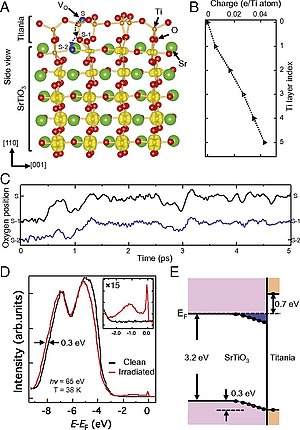Anisotropic two-dimensional electron gas at SrTiO3(110)
Category: Scientific HighlightsPublished in PNAS
Although still in its infancy, electronics based on all-oxide materials is a rapidly developing field, and strontium titanate is its key player. For this area to thrive, an atomic-scale control and understanding of the materials’ surfaces and interfaces needs to be achieved. A SrTiO3 crystal with (110) orientation automatically forms an overlayer that is more insulating than the bulk and chemically less reactive, akin to the native SiO2 on conventional wafer. With appropriate doping a two-dimensional electron gas (2DEG) forms underneath the SrTiO3(110) surface. This (110) 2DEG is very different from (001): The effective mass here depends on the quantum number, and a completely flat band can be realized. Such a flat band bears good prospects for, among others, magnetism and thermoelectricity.
ABSTRACT:
Two-dimensional electron gases (2DEGs) at oxide heterostructures are attracting considerable attention, as these might one day substitute conventional semiconductors at least for some functionalities. Here we present a minimal setup for such a 2DEG––the SrTiO3(110)-(4 × 1) surface, natively terminated with one monolayer of tetrahedrally coordinated titania. Oxygen vacancies induced by synchrotron radiation migrate underneath this overlayer; this leads to a confining potential and electron doping such that a 2DEG develops. Our angle-resolved photoemission spectroscopy and theoretical results show that confinement along (110) is strikingly different from the (001) crystal orientation. In particular, the quantized subbands show a surprising “semiheavy” band, in contrast with the analog in the bulk, and a high electronic anisotropy. This anisotropy and even the effective mass of the (110) 2DEG is tunable by doping, offering a high flexibility to engineer the properties of this system.
| Figure: SrTiO3(110)-(4 × 1) surface. (A) Structural model; an oxygen vacancy (VO) formed at the reconstructed surface spontaneously migrates to the (SrTiO)4+ plane beneath the top titania layer. The excess electrons from the VO form a 2DEG confined within a region of about 2 nm thickness. The layer-dependent charge is represented by the yellow lobes and plotted in B. (C) MD simulation of the VO diffusion from the surface (S) to the subsurface (S-2) sites represented by the accompanying upward oxygen migration from S-2 to S-1 (blue line) and from S-1 to S (black line). (D) Angle-integrated photoemission spectroscopy of the clean surface and after creating VOs by synchrotron radiation. An in-gap state and a metallic peak near the Fermi level (EF) develop (Inset). (E) Schematic band structure at a surface with VOs; the bands bend downward by 0.3 eV as deduced from the spectra in D. The dots denote the surface potential obtained from the shift of Ti 3s states in DFT+U calculations. | |||
|---|---|---|---|---|
Wang Z., Zhong Z., Hao X., Gerhold S., Stoger B., Schmid M., Sanchez-Barriga J., Varykhalov A., Franchini C., Held K., Diebold U. (2014), Anisotropic two-dimensional electron gas at SrTiO3(110), PNAS 111, 3933–3937. DOI:10.1073/pnas.1318304111, OpenAccess
Other Recent ViCoM Publications
Sensengasse 8/12
A-1090 Vienna
AUSTRIA
T: +43-1-4277-51401
F: +43-1-4277-9514



